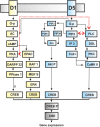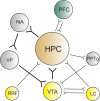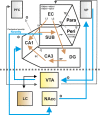Dopamine D1/D5 receptors mediate informational saliency that promotes persistent hippocampal long-term plasticity
- PMID: 23183712
- PMCID: PMC3948488
- DOI: 10.1093/cercor/bhs362
Dopamine D1/D5 receptors mediate informational saliency that promotes persistent hippocampal long-term plasticity
Abstract
Dopamine (DA) plays an essential role in the enablement of cognition. It adds color to experience-dependent information storage, conferring salience to the memories that result. At the synaptic level, experience-dependent information storage is enabled by synaptic plasticity, and given its importance for memory formation, it is not surprising that DA comprises a key neuromodulator in the enablement of synaptic plasticity, and particularly of plasticity that persists for longer periods of time: Analogous to long-term memory. The hippocampus, that is a critical structure for the synaptic processing of semantic, episodic, spatial, and declarative memories, is specifically affected by DA, with the D1/D5 receptor proving crucial for hippocampus-dependent memory. Furthermore, D1/D5 receptors are pivotal in conferring the properties of novelty and reward to information being processed by the hippocampus. They also facilitate the expression of persistent forms of synaptic plasticity, and given reports that both long-term potentiation and long-term depression encode different aspects of spatial representations, this suggests that D1/D5 receptors can drive the nature and qualitative content of stored information in the hippocampus. In light of these observations, we propose that D1/D5 receptors gate hippocampal long-term plasticity and memory and are pivotal in conferring the properties of novelty and reward to information being processed by the hippocampus.
Keywords: cognition; hippocampus; learning and memory; review; synaptic plasticity.
Figures



References
-
- Adcock RA, Thangavel A, Whitfield-Gabrieli S, Knutson B, Gabrieli JD. Reward-motivated learning: mesolimbic activation precedes memory formation. Neuron. 2006;50:507–517. - PubMed
-
- Bach ME, Barad M, Son H, Zhuo M, Lu YF, Shih R, Mansuy I, Hawkins RD, Kandel ER. Age-related defects in spatial memory are correlated with defects in the late phase of hippocampal long-term potentiation in vitro and are attenuated by drugs that enhance the cAMP signaling pathway. Proc Natl Acad Sci U S A. 1999;96:5280–5285. - PMC - PubMed

